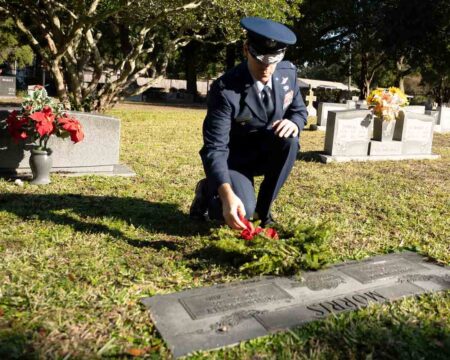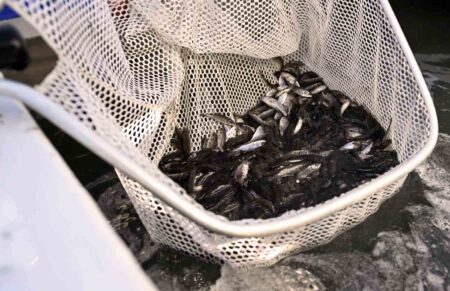Here’s what is known about the Mayflower:
It was a merchant ship.
The ship’s master was also a part-owner and shared in its profits.
Port records show the ship sailed between England and France, transporting wine cargo, 12 years before its famous voyage.
Historically, ships headed for what was called the New World left England in February or March. But, due to a combination of religious and contract disputes, the Mayflower left port late on Sept. 6, 1620, practically guaranteeing its Pilgrim cargo would sail into storm and hurricane season.
The Pilgrim story is part of American mythology, captured in the annual Thanksgiving feast. But the true story is intertwined with exploration, transportation, and the Atlantic Ocean, which leads back to the Mayflower.
Far more is known about a small religious sect of pioneers—50 men, 20 women, and 32 children, including William Bradford, Myles Standish, and John Alden—than the ship and the crew that assured their arrival in the New World.
In fact, so little is known about the ship, its crew, and the actual voyage that maritime historians rely on secondary sources about 17th-century navigation to fill in the gaps, says Jolyon Rollins of Plimoth Plantation, a “living” history replica of the original Pilgrim Village in Plymouth, Mass.
There is no doubt, however, that navigating the open sea was a dirty, dangerous business in the 1600s.
“In the parlance of sea life, you always hire more men than you need, knowing some of them will become fish food,” Rollins says.
Of course, no global positioning system was on board to tell seaman how to get to the New World. They relied on their knowledge of math, astronomy, and crude instruments to measure where they were, what direction they were headed, and the distance they traveled.
Even more problematic for 17th-century navigators, there was no accurate way to tell time, which meant, in a roundabout way dealing with longitude, sailors never knew precisely where they were.
“Any sailor worth his salt could gauge his latitude well enough by the length of the day, or the height of the sun, or certain guide stars above the horizon,” writes Dava Sobel, author of the best-selling book “Longitude.” But longitude, she notes, had to be measured by time.
The longitude problem frustrated great explorers for centuries and contributed to countless deaths at sea. Solving it is at the heart of some of the most fascinating episodes in maritime history. Additionally, several key navigating instruments depended on the sun to operate. Thus, they weren’t usable at cloudy, overcast times.
“That’s one of the reasons they call it the art, not the science, of navigation,” Rollins says.
When Rollins goes to work on Plimoth Plantation’s Mayflower II, a full-scale reproduction of the original ship, he literally becomes Robert Coppin, an officer aboard the Mayflower of 1620.
“My character is largely based on what we know of the life of a sailor at the time,” Rollins says.
Coppin, who may have been the ship’s pilot, answered to Christopher Jones, the ship’s master or captain, and Robert Clarke, the second-in-command.
“We believe Chris Jones never had to do any of the navigating,” Rollins says. “We think it was Robert Coppin and John Clarke doing the majority. They had come here before. They knew what they were doing.”
The crew consisted of about 30 men, approximately one-third of them officers. Beyond the officers, there is no record of the names of crew members.
Because of timekeeping, a sailor’s day began at noon, Rollins says. That’s the one time they could be sure of starting time accurately by tracking the sun’s position in the sky.
The modern-day crew of the Mayflower borrows heavily from the 1622 book “Sea Grammar” for its knowledge of 17th-century navigation.
According to the book’s author, John Smith, a competent seaman needs a compass, good charts, and a tool to measure latitude. In his time, the tools were either a cross staff or an astrolabe. Both contraptions helped sailors measure latitude by measuring angles between the sun, the horizon, and certain stars.
By the way, the John Smith of “Sea Grammar” is the same John Smith whose life was reportedly saved by Pocahontas, the same John Smith known best for his role at Jamestown, the first permanent English settlement.
As an aside, Rollins says Smith also wanted to captain the Mayflower during the Pilgrim’s trip. But the Pilgrims decided it would be easier to deal with his maps than him.
Still, there is some knowledge of what happened to John Smith and some evidence of what happened to the Pilgrims, but what happened to the Mayflower?
The ship survived the storms at sea, and the crew finally sighted land in November 1620. The Mayflower remained in Plymouth for five months, mainly so its former passengers would have someplace to live while they built homes and planted gardens.
In April of 1621, the ship returned to England and to the wine trade. Christopher Jones died in 1622. There are no records on the Mayflower until 1624, when Jones’ widow and three other owners asked for an appraisal. After the appraisal came in, the widow Jones described it as “in ruins.”
And the last thing known about the Mayflower is that it was torn apart for scrap.
ABOVE: A harrowing scene of the Mayflower at Sea by Mike Haywood.







